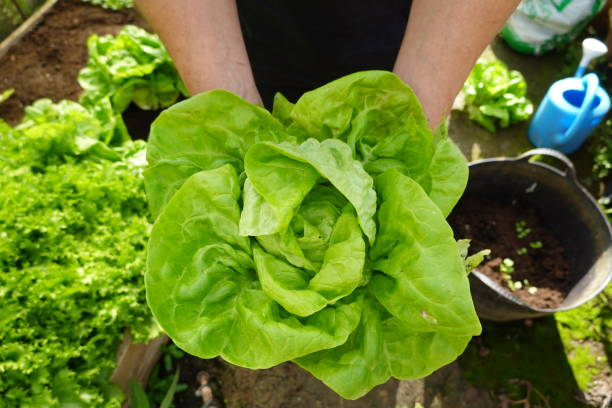Growing salad leaves at home is an easy and rewarding activity that can provide you with fresh greens all year round. Whether you have a large garden, a small balcony, or just a windowsill, you can grow salad leaves successfully by following some basic principles. Here’s a comprehensive guide on how to cultivate your own salad greens to enjoy crisp, fresh salads whenever you like.
Choosing the Right Salad Leaves

The first step in growing salad leaves is selecting the right types. There are many varieties of salad greens available, including lettuce, spinach, arugula, and mizuna. Each type has its own growth pattern and flavor profile, so consider mixing different varieties to create a diverse and flavorful salad bowl. Most salad greens are cool-season crops, which means they grow best in the spring and fall.
Popular Varieties of Salad Leaves
-
Loose-leaf Lettuce:
Easy to grow and versatile. Comes in many colors and textures. -
Spinach:
Rich in nutrients and can be eaten raw or cooked. -
Arugula:
Has a peppery flavor and grows quickly. -
Mizuna:
A Japanese green with a mild, mustard-like flavor.
Preparing the Soil
Good soil preparation is key to growing healthy salad leaves. Salad greens prefer well-drained, fertile soil that is rich in organic matter. Start by loosening the soil to a depth of at least 6 inches and adding compost or well-rotted manure. This will enhance soil fertility and structure, improving moisture retention and providing the nutrients your salad leaves need to thrive. If you are planting in containers, use a high-quality potting mix, ensuring good drainage.
Planting Your Salad Leaves
Once your soil is prepared, it’s time to plant your salad leaves. You can sow seeds directly into the soil or start them indoors in seed trays. If you’re sowing directly, plant the seeds at a shallow depth of about 1/4 inch and space them according to the package directions. Keep the soil consistently moist, but avoid overwatering, which can lead to disease. If starting indoors, transplant seedlings to the garden or larger containers once they have a few true leaves.
Caring for Your Salad Leaves
Salad leaves require regular care to ensure a healthy crop. Water your plants evenly and consistently, aiming to keep the soil moist but not waterlogged. Mulch around the plants to help retain moisture and reduce weed growth. Salad greens are relatively low-maintenance, but they can benefit from occasional feeding with a balanced fertilizer. Monitor your plants for pests such as aphids or slugs and manage them with appropriate organic treatments.
Watering Tips
- Water early in the morning to minimize evaporation.
- Avoid wetting the leaves to prevent fungal diseases.
- Use drip irrigation or soaker hoses for efficient watering.
Harvesting Salad Leaves
Knowing when and how to harvest your salad leaves is crucial for continuous production. Most salad greens can be harvested as soon as they are large enough to eat, usually within 3 to 4 weeks of planting. Cut the outer leaves first, leaving the center of the plant to continue growing. This method, known as “”cut-and-come-again,”” allows you to enjoy multiple harvests from the same plants. For the best flavor, pick leaves early in the morning when they are crisp and full of moisture.
Conclusion
Growing your own salad leaves is a simple and enjoyable way to ensure a steady supply of fresh, nutritious greens. By choosing the right varieties, preparing your soil properly, and tending to your plants with care, you’ll be able to savor the vibrant flavors of homegrown salads. Plus, the process of gardening itself can be therapeutic and satisfying. Whether you’re a seasoned gardener or a beginner, starting with salad leaves is a great way to embark on your gardening journey.
FAQs
1. How often should I water my salad leaves?
Salad leaves should be watered consistently to keep the soil moist but not waterlogged. Generally, watering 2-3 times a week is sufficient, but this can vary based on your local climate and soil conditions.
2. Can I grow salad leaves indoors?
Yes, salad leaves can be grown indoors. Ensure they receive adequate light, either from a sunny windowsill or under grow lights, and use containers with good drainage.
3. How do I prevent pests on my salad leaves?
To prevent pests, regularly inspect your plants and use organic treatments if needed. Companion planting with herbs like basil can also deter pests. Keeping a clean garden area helps reduce pest habitats.
4. When is the best time to plant salad leaves?
Salad leaves are best planted in the cool seasons of spring and fall. However, with the right conditions and care, you can grow them year-round, especially indoors or in mild climates.
5. How do I harvest salad leaves without killing the plant?
Use the “”cut-and-come-again”” method by harvesting the outer leaves first. Leave the central part of the plant intact, allowing it to continue growing and producing new leaves.


